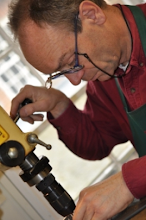I am working on a beautiful carriage clock or should I say timepiece because it does not strike. But it has an alarm. The alarm mechanism is extremely sensitive to the correct springiness in a thin rod-spring (see picture below) that releases the alarm.
It took me quite a while to figure out how to get the alarm right and where to focus and intervene to get it to work reliably. I must make a point to explain to the client that alarms are finicky and have a character of their own. The slightest change in the springiness of that rod-spring can silence the alarm forever or, worse, keep it running until the alarm spring is fully unwound; after which winding it may no longer be possible because the rod-spring will not lock the alarm arm any longer. I wonder if this rod-spring is so sensitive that a change in temperature or humidity might already cause it to malfunction? Or, could it be hysteresis? In other words the sheer fact of the spring being pushed repeatedly could make it less springy over time.
I was so pleased that I got the alarm to go off reliably after quite a few trial and error iterations. So, I put the carriage clock together again with a feeling of great satisfaction that another clock can go to the test bench for about ten days before being returned to the client. And, once that happens, getting paid!
So my frustration was hard to control when I had the clock all finished and in its case again to only notice then that if I set the minute hand to time the alarm hand would move along. Why on earth was this happening? It couldn't possibly be a feature of the carriage clock? So what caused this?
I took the whole clock apart again and started burnishing the stud on the alarm setting wheel that rubs against the alarm setting disc (see picture below: the alarm setting wheel is second from top left, the disc is just below it). I assumed there was too much friction between the disc and the stud.
After a while I noticed that the alarm setting arbor has a four armed friction washer (see picture below: the four armed friction washer is just below the number 390) pressing against the inside of the back plate.
This washer must be there to introduce sufficient friction for the alarm hand not to turn along with the minute hand when you are setting the minute hand to time. While, when you set the alarm, this washer must not have enough friction to prevent you from turning the alarm setting arbor. So again we seem to be working here with a part that is ever so finely balanced. I can already see more trial and error iterations coming!
I then noticed that this friction washer which looks like a starfish was doing a miserable job. It just hung there on the arbor flat as a pancake, while it should be pushing the alarm setting arbor away from the back plate. When it does that properly it will create minimal friction when the alarm setting wheel stud travels over the surface of the alarm setting disc.
So now, my next move will be to either bring life back into this washer by hammering it convex again, or make a new one and then see if the alarm hand will stay put when I turn the minute hand.
To be continued.



